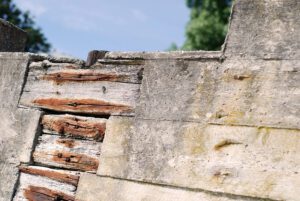Living on a seafront property is something you want to protect. After all, you don’t want your home or business to be under the sea where the creatures don’t sing and Ariel will have more items added to her collection. So it’s no wonder you want your seawall to succeed.
But what if your seawall is already failing? Don’t worry. Your home won’t be part of the underwater city of Rapture. Your seawall can be repaired once and for all.
Dalinghaus Construction works in Southern California, Arizona, and Nevada with over 100 years of combined experience in foundation repair and seawall repair. We want you to know what happens when a seawall fails and how it can be repaired.
What makes a seawall fail?
Salt from the ocean

Salt is like the friend that comes to your home and eats all the snacks you bought. Yeah, guests can have their pick of those snacks, but you still want some left over for you.
Any type of water can affect your seawall. Concrete is porous and able to make contact with the rebar inside eventually. The added factor of salt will eat at your seawall.
This is a problem engineers have been trying to combat with seawalls.
Hydrostatic pressure
When you spray a wall with a super soaker, water goes flying everywhere. Except this super soaker is the ocean or a large body of water. Even a little bit of water will make it past your seawall and soak into the soil. The soil will soak in the water, adding more pressure onto your seawall.
Improper seawall construction
Some contractors don’t like to follow the instruction manuals. It would be nice to have procedures memorized, but referring back to the book doesn’t hurt anyone.
Like some model kits, there may be extra parts added to your seawall. The concrete may not have been mixed correctly, or there was too much rebar. Or maybe there wasn’t enough of either.
Seawall depth
When you dive into the pool, you can feel at least a little pressure as the water makes contact with your skin. The same goes for a seawall. The deeper a seawall is, the more pressure is added onto it, especially as the tides go high and low.
Seismic activity
You can get a rumble in your stomach to tell you you’re hungry. The earth does something similar, except on a larger scale (and less hungry).
Southern California is susceptible to earthquakes. That rumbling can cause damage even to the most well-constructed building.
Age
Everything gets old and deteriorates over time. Your seawall is no exception. Thankfully, seawalls can be repaired and replaced to alleviate the aging issue.
Check out our in-depth article about the six causes of seawall failure.
Signs and symptoms of a failing seawall
Soil Loss
- Have you been subject to living with that one person that is secretly making your whiskey bottle empty? It’s sort of like that, except it puts your property in danger.
- Water crashes on the seawall all the time as the tides continuously change. When the water pulls back, the soil goes with it.
Leaning
- Your seawall is building up enough hydrostatic pressure that it looks like it’s had too much of that whiskey, struggling to stand up straight.
Deterioration
- Salt will naturally eat away your seawall and cause some concrete spalling. It’s like you can tell your wall has had too much of that whiskey.
Cracking
- You’ll identify large cracks when you take a look at your seawall. Your wall is admitting it’s had too much of that good whiskey.
Oxidizing rebar
- This isn’t as noticeable but can cause larger damage. As the rebar oxidizes, it expands, causing additional cracks in your wall since it’s expanding from the inside.
- As water crashes into the seawall, you’ll see rust stains that make your wall look as though it’s weeping.
- You can tell your seawall has had too much of that whiskey and is trying to get rid of it in the bathroom.
What a waste.
Learn more about the signs and symptoms of a failing seawall.
Issues of a failing seawall
Soil erosion

This is the number one issue. The ocean and other masses of water have a give-and-take relationship with the land. As the waves crash onto the shore or your property, it’s taking soil.
While the relationship sounds cool, your home or business building doesn’t want to be taken into the water. Our standard homes aren’t sustainable to be part of the lost city of Atlantis.
Either way, the whole point is to not lose your home
Concrete deterioration
As discussed earlier, salt likes to eat concrete. And if your seawall has cracks in it, the water will make its way to your rebar, causing it to oxidize – also known as rust.
Concrete isn’t exactly malleable. Expanding rebar will cause your concrete to blow out, further compromising the integrity of your seawall. The failure of your seawall will only contribute to soil erosion.
Repairing your seawall (once and for all)
Soil stabilization

If your concrete is okay, you may have to worry about the hydrostatic pressure buildup and the weep holes the water escapes.
You’ll want a professional to come and maintain the weep holes and make sure there isn’t any blockage.
The weep holes aren’t only getting rid of water behind your seawall; the soil is also escaping. Voids are created in the soil as water escapes, which can compromise the integrity of your wall.
Plus, you don’t want to step on a patch of weak soil.
Polyurethane will be injected into the soil behind your wall to maintain stability. That way the soil behind your seawall is stronger and supports your seawall in doing its job.
Carbon fiber
Carbon fiber being applied to your seawall depends on the severity of the cracks. A carbon fiber wrap will be applied to your seawall for waterproofing if the solution requires that particular fix.
Your cracks will be addressed and water won’t be allowed access. The carbon fiber will have your seawall working as well as new without the water oxidizing the rebar.
Schedule a free seawall evaluation
You’ve learned about what makes a seawall fail, the signs of a failing seawall, issues you’ll have if your seawall fails, and how to repair a failing seawall once and for all. Make sure your seawall is in good condition to keep your home or business safe.
Make sure your seawall is secured once and for all. Dalinghaus Construction can evaluate your seawall for free to see if any issues need to be addressed.
Learn the best practices to prevent seawall failure.
For additional questions or to schedule an appointment, call Dalinghaus Construction at (877)360-9277.





